near Allison Street Post O ce
What’s that smell?
Arvada residents complain of foul odor near Lake Arbor
BY RYLEE DUNN RDUNN@COLORADOCOMMUNITYMEDIA.COMYou’re not having a stroke; it really smells like rotten eggs by Lake Arbor Park. Many north Arvada residents have complained about a foul smell emanating from the nearby park in recent weeks, and city o cials say they’re working to mitigate the problem.
e city is working on a project to improve public safety at the park by stabilizing the banks of the lake. In order to complete the renovation work, the city has to drain the lake two and a half feet — which should be done in a matter of weeks, according to Arvada’s Communications Manager for Infrastructure Katie Patterson.
Marco Antonio Garcia selected by Arvada Arts and Culture Commission to paint mural
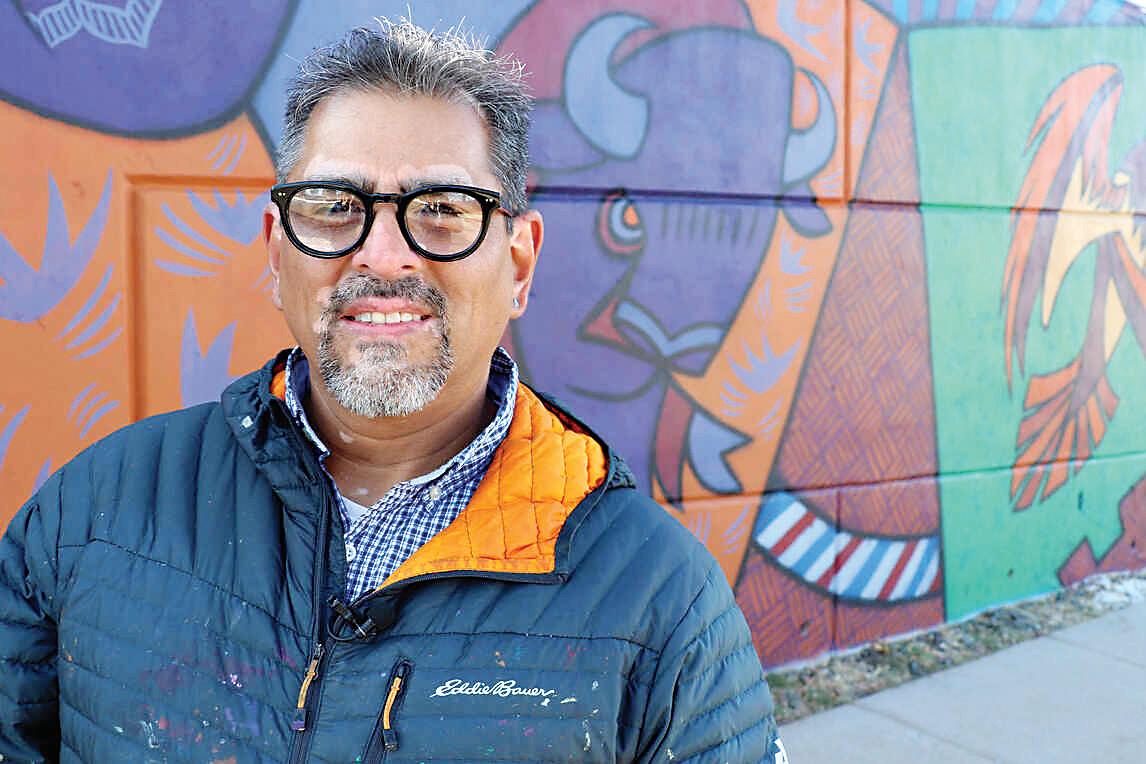

 BY RYLEE DUNN RDUNN@COLORADOCOMMUNITYMEDIA.COM
BY RYLEE DUNN RDUNN@COLORADOCOMMUNITYMEDIA.COM


Marco Antonio Garcia has completed a mural on a retaining wall adjacent to the Allison Street Post O ce in Arvada which celebrates the connection of loved ones near and far. ‘La Letra’ was commissioned by the Arvada Arts and
Culture Commission to beautify the structure.
Garcia, a Colorado-based artist with roots in Mexican culture, was selected out of over 70 applicants.
Garcia’s work includes murals and other public art installations, in addition to work in other styles.
According to Garcia, the mural represents the connection he maintained with his family in Mexico while living far away.
“I wanted to connect it to the Post O ce, but I also wanted it to have an important story,” Garcia said.
“When I was younger, my mom used to send letters to my grandmother in Guadalajara, (Mexico). It’s hard to be away from your family, and if
the only connection you have is this letter, then it’s really important.”
Garcia continued that it’s also important for people to have art in their lives because it’s an inspiring energy.
“It’s necessary for our well-being,” he said. “It’s also letting the community know that we care about you. is is for you, it’s a gift for you.”
AACC member Kimberly Wagner praised the nished mural.
“ e blank wall here before could really only be improved upon,” Wagner said. “Looking at it (now), I love how dynamic and vibrant it is.”
e Allison Street Post O ce is located at 5885 Allison St. in Arvada.
Stormwater Administrator Jacob Moyer said that crews became aware of the pungent smell when they began draining the lake, and stopped work to try to mitigate the stench. Moyer said the mitigation e orts have helped, but not eliminated the smell, but added that none of the renovation work would have any negative public health e ects for neighborhood residents.
“ is is naturally occurring hydrogen sul de,” Moyer said. “ is is produced when bacteria break down plant and animal material, often in stagnant waters with low oxygen content… Unfortunately, with the additional layer of ice on the water, the water does not have as much oxygen aerating the water.
“ is makes the smells in the
SEE SMELL, P3
Working to preserve history
South
BY DEB HURLEY BROBST DBROBST@COLORADOCOMMUNITYMEDIA.COMA dilapidated historic building near Buffalo Creek may get new life now that it is on Colorado’s Most Endangered Places list.
The South Platte Hotel, which was built in 1913, is in the North Fork Historic District and the only building remaining of the South Platte community. The property has been owned by Denver Water since 1987, and the building was slated for demolition.

The Most Endangered Places list is created each year by Colorado Preservation Inc., and the organization announced on Feb. 9 additions to the list, which included the South Platte Hotel.

Last August, the Jefferson County Historic Commission received a letter from Denver Water stating that the building would be demolished, which made John Steinle, a local historian, spring into action.
“We have talked about that building for a long time, what might be done and how it could be saved,” Steinle said. “The letter put us into emergency mode. What (the letter) did was galvanize us, and we contacted a lot of local organizations to get them mobilized and aware of the situation.”
Among the organizations interested in preserving the building are the Evergreen Mountain Area Historical Society, the Conifer Historical Society, the Pine Elk Creek Improvement Association and Jefferson County Open Space.
Steinle hopes the organizations can meet with Denver Water officials and put their heads together to come up with a plan.
“Our next step is to contact the decisionmakers at Denver Water and have a discussion of what they are amenable to do,” Steinle said.
“Hopeful we can work with them in the near future and keep them from tearing it down and figure out what to do with it.”
Colorado Preservation Inc. will facilitate and assist the local orga-






nizations with finding a solution to keep the building, said Endangered Places Director Katie Peterson, who noted that it takes local community initiative to preserve historic sites.
She said since the hotel was so close to the Colorado Trail and the South Platte River, options should be available to keep the building.
According to Jose Salas, a Denver Water spokesman, Denver Water bought the hotel building because it would be within the area underwater with the proposed Two Forks Reservoir, which ultimately was never built.
“With no waterworks purposes for Denver Water to warrant the expenditure of ratepayer funding for building repairs, the structure has progressively deteriorated over the last four decades and is currently extremely unsafe,” Salas wrote in an email. “Denver Water has installed fencing to deter the public from trying to enter the unsafe structure while we go through the process of determining its future.”
He said Denver Water understood the site’s historic significance and wanted to work with other groups to determine potentially viable options, and no decisions have been made.
Hotel history
The community of South Platte was at the confluence of the North Fork of the South Platte River. According to Preservation Colorado, the hotel originally was constructed in 1887 by Charles Walbrecht and his wife Millie, an example of a working-class resort hotel. In its day, the hotel offered 14 rooms to stagecoach passengers and train passengers on the Denver, South Park and Pacific Railroad narrowgauge line.
Steinle said many communities sprang up in the late 1800s along the railroad, especially between Buffalo Creek and Pine Grove, a
reminder of how intense railroading was in Colorado and how important the railroads were to the state’s economy.
The hotel also operated a post office, and by 1900 the town, population 40, included the hotel, railroad-related businesses and a general merchandise store. Five years later the Walbrechts expanded the hotel to include a saloon.
According to legend, the hotel was set on fire and burned to the ground in 1912. It was replaced with the structure that is still standing today, according to Preservation Colorado.
Student involvement
It’s not just area historical societies who are interested in preserving the South Platte Hotel. In the 2012-13 school year, West Jefferson Middle School English teacher Frank Reetz and a team of students embarked on a project to restore the Billy Westall Monument near the South Platte community. This project was successfully completed in 2014 and recognized by the Jefferson County Historical Commission.
With that success, Reetz and his students began studying the South Platte Hotel, and students wrote essays on what should be done with the building, especially given its neglected state, that were published in 2018 in the periodical “Historically Colorado.”
While a few students said the building was too expensive to renovate and preserve, some suggested restoring it to a functioning hotel, preserving part of the building, or creating a park on the property as a way to preserve its history.
As one student put it: “We must protect this historic space from the forces of nature. We cannot let the destruction of this area. It is spiritual and special to the community.”
Platte Hotel placed on endangered places list
water from sh, goose poop, algae and other pollutants can be more potent,” Moyer continued. “Please note in low concentrations like this, there are no known negative public health e ects of naturally occurring hydrogen sul de.”
Mitigation e orts employed by the work crews include adding deodorizing blocks, slowing the ow of the drain and other aeration techniques. Moyer estimated about two more weeks of draining will be needed to nish that state of work.
After the draining is done, construction will begin
Colorado
around the lake’s shoreline, which has eroded in recent years and is considered unsafe. e project will also seek to improve the water quality at the lake, which has had consistent issues with odor and algae, especially in the summer.

To combat these challenges, a stable rock and vegetation shoreline will be installed to reduce erosion around the lake. Wetland plants and grasses will be planted around the perimeter to help with that, and more aerators will be planted to elevate oxygen levels and break down algae in the lake.
e project aims to be completed by 2024, according to the City of Arvada’s website.




Environment
Golden Real Estate has proudly cosponsored this unique film festival for at least a decade. For the first time since 2020, the festival is back live at the American Mountaineering Center (AMC) in downtown Golden Feb. 23-26, but most of the films can also be viewed with an online pass starting the following week.

During the pandemic, the festival (“CEFF”) was only virtual, and I loved it because I was able to see far more films than I could have seen in person.
Meanwhile, if you go online to http:// ceff2023.eventive.org/films, you get to read descriptions and view trailers for all 97 films in the festival. At right is a screenshot from that website, showing just three of those films’ thumbnails. I was particularly drawn to “The Power
ADVERTISEMENT
Film Festival Is Back Live Next Week, Featuring 90+ Films
of Activism,” and look forward to seeing the full 53-minute Australian film about six young women activists out to save the planet. “Purple Haze” is about the purple martin, described as “America’s favorite backyard bird.”
An in-person “all access” pass costs $90 and can be purchased at the same website. The virtual pass is $75.
As before, the films are combined into 28 “collections” such as the “Activism Collection” (my favorite), which can be purchased for $12 each if you don’t want to buy the all-access or virtual pass. All the information is on that website. Click on the “Menu” link at the top left of the website to see the various pages with all the information you need to attend the festival.
Bill in Legislature Would Enlarge Board of Commissioners
Back in 2013-2014, I was part of a group called “Jeffco5” which ran an unsuccessful petition drive to put on the 2014 ballot an initiative that would increase the number of Jeffco Commissioners from three to five and to require that they be elected by district instead of at large.
At the time, the Jeffco Board of Commissioners consisted to two Republicans and one Democrat, and they voted 2-1 against enlarging the board to five members, hence the petition drive. Like our 5-member school board, all three commissioners must run countywide, even though they are assigned one-third of the county as their “district.”
I mistakenly assumed that once at least two of the commissioners were Democrats, that they would put the measure on the ballot. Currently, all three commissioners are Democrats, and it’s still not happening.
Last week I ran into one of the commissioners, Andy Kerr, at an event honoring Brittany Petterson, our new member of Congress who succeeded Ed Perlmutter, and asked him about the idea.
He said he favored it, but informed me about a bill (HB23-1180 ) being put forward in the General Assembly by Rep. Bob Marshall and State Sen. Kevin Priola which would require all counties with a population over 70,000 to have five county commissioners, at least three of whom are elected by district. Andy told me that if that measure fails, he
would consider convincing his fellow commissioners to put such a measure on the Jeffco ballot this fall.
Colorado’s Open Meetings Law (OML), which originated in a citizen initiative known as the Colorado Sunshine Act of 1972, defines a meeting as “any kind of gathering, convened to discuss public business, in person, by telephone, electronically, or by other means of communication.” It prohibits any members constituting a quorum of a “local public body” from even talking with each other about a public policy without that meeting being given “full and timely notice” and being opened to the public.
The implications are that any Jeffco commissioner who converses with or emails a fellow commissioner about a county policy or issue is violating state law, because together they would constitute a quorum of the 3-member Board of County Commissioners. To me, this is the compelling reason why the board must be enlarged to five members.
The argument for electing the commissioners (and school board members) by district instead of at large is equally compelling. If each commissioner must win the votes of a plurality of voters countywide, he or she is not going to give his assigned portion of the county the attention it deserves.
I will testify in favor or HB23-1180 and urged our commissioner to do so as well.
As in past festivals, there is a free (but ticket required) “Community Opening Night” on the 23rd which includes announcement of the winning films in various categories. It starts at 6 pm in the AMC auditorium and is followed at 7:15 by the screening of seven of the awardwinning films, ranging from a one-
ue for the festival at the American Mountaineering Center, but a second theater is created in the AMC’s event center to accommodate all the screenings, which begin at 10 a.m. from Friday through Sunday. The virtual access ticket (which I’m going to get) allows you seven days to watch any or all of the films on demand.
The festival features young filmmakers from around the nation including
minute PSA to a couple 23-minute films. I never miss this event, which is held in the AMC’s Foss auditorium.
Although CEFF is an international film festival, several of the “collections” feature films made by Colorado filmmakers. There are also 16 “accessible collections” which are either captioned, subtitled or have no dialog. One collection is of the “Top 10 Best Kids’ Short Films.”
Other collections which caught my attention include: Art in Nature; Climate Chaos; Feathered Friends & More; Innovation & Inspiration; Off the Beaten Path; People to Know; Special Places; Unique Solutions; and two Wildlife Collections
If you are reading this column in time, there’s a free Festival Preview at the University of Denver’s Sturm Hall on Thursday, Feb. 16th, 6:30 to 8:30 pm.

The Foss auditorium is the main ven-
Hawaiian youth-made films like “Sunscreen Standoff,” and local Colorado young filmmakers like Taylor Saulsbury who gives voice to her generation's climate anxieties, creating portraits of resistance and resilience in “Right Here. Right Now.”
Join in the free virtual “Green Bag Lunch & Learn Series” to hear from local experts as they dig deeper into current event environmental issues, including a closer look at the impact of Climate Chaos on young people’s mental health (Wednesday, March 1st at noon).
By attending the festival in person, you get to join the conversation with Filmmaker Q&A Sessions after many of the films to chat live with the filmmakers in attendance or watch one of the many recorded sessions to hear the secrets and intriguing behind-the-scenes stories of the films featured in this year’s festival. Don’t miss this great festival!
Jim SmithBroker/Owner, 303-525-1851


Pet Wants opens brick-and-mortar shop in Olde Town Arvada
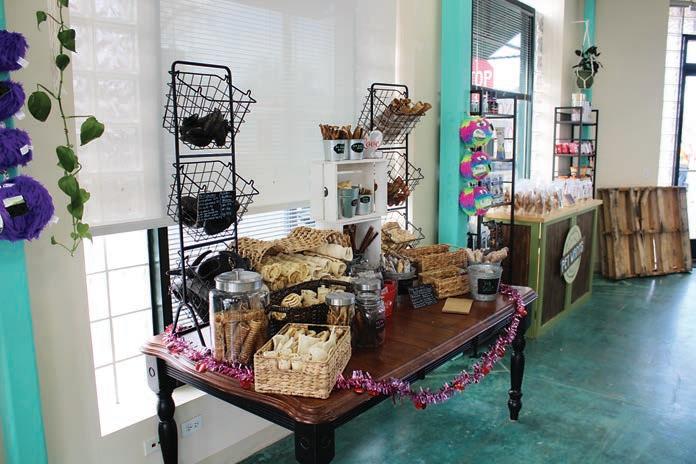

Holiday Markets.
“The people were nice, and there’s a nice community of small businesses,” Hodge said of Arvada. “There’s great foot traffic; it’s close to Denver while still being a suburb. As much as this area is growing, this is the most established of the suburbs.”




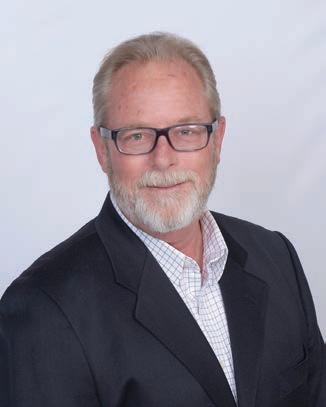 BY RYLEE DUNN RDUNN@COLORADOCOMMUNITYMEDIA.COM
BY RYLEE DUNN RDUNN@COLORADOCOMMUNITYMEDIA.COM
In the beginning, Sharon Hodge just wanted to find healthy food for her pups; Olive and Petey. Both the pups are cancer survivors, and Hodge didn’t want to give them anything she hadn’t properly vetted.
Hodge became involved with Pet Wants — a national pet food franchise — while she was living in Nashville. She fell in love with the company’s mission; fresh, organic pet food made mostly domestically.
Hodge’s Pet Wants location opened up shop at the corner of Grandview Avenue and Yukon Street — the former location of New To You, a defunct consignment store — earlier this month.
When Hodge moved from Tennessee to Colorado, she was inspired to open her own franchise location. She says she was drawn to Arvada because of the community feel she experienced while participating in local events like the farmer’s market, Second Saturdays and the Olde Town Square
Pet Wants’ food is manufactured in New York state every six weeks, which keeps the store’s stock fresh.
“My whole thing is, ‘Everything should be natural,’” Hodge said. “I don’t want to give my pets anything that I don’t 100% trust. Pet health is so important because they’re my family. I won’t carry anything I wouldn’t give to them.”
Hodge said she hopes the store can become a community hub that supports local vendors.
“I don’t want this to just be a pet store, I want it to be a community gathering space,” Hodge said. “I want it to be a place for people to make friends and connect with people in their community.”
To that end, Pet Want’s Arvada location will feature events, including pet massage therapy and rescue pup yoga. Information about events can be found on the Arvada store’s social media.
The Arvada Pet Wants location is currently closed on Mondays and open from 11 a.m. to 6 p.m Tuesdays and Wednesdays, 11 a.m. to 7 p.m. Thursdays and Fridays, 10 a.m. to 6 p.m. Saturdays and noon to 5 p.m. Sundays.

Owner Sharon Hodge got into the business to care for her two pups, both cancer survivors
Je co teacher’s union bargains for higher pay and more planning time
Feb. 1.
BY ANDREW FRAIELI AFRAIELI@COLORADOCOMMUNITYMEDIA.COM
Compensation was one of the top bargaining priorities that the Jefferson County Education Association, the county’s teacher’s union, presented to the Board of Education, along with the need for more paid planning time.
“We need to respect educators as experts, and ensure their voices are centered when making decisions regarding learning and working conditions,” Brooke Williams, the JCEA president, said at the start of the Feb. 1 meeting.
Eleven members of the JCEA were in attendance, with Williams’ statement setting the tone for most of their points to the Board including that the need for more planning time was not just a matter of convenience for teachers, but the only way to better the District’s education.
“Even if teachers are receiving all their plan time (225 minutes per week) it is not enough,” part of the JCEA’s presentation said. Addressing learning gaps “are not going to happen on the y,” they added.
Board Vice President Susan Miller questioned how to analytically show that extra planning time was actually e ective.
“I would like to know, you said at the very beginning in bargaining, we’d improve student learning outcomes, and I’d like to understand how that happens,” Miller said. “Because I’d like to understand if we give more PLC time, if we provide more planning at the di erent levels, etc., what is the bene t for
our children that we should be able to measure?”
Williams told Colorado Community Media that she “doesn’t think it’s any secret that teachers need time to make phone calls to parents, they need time to grade and they need time to prepare their lessons.”
She added that having enough time to also observe other teachers would be bene cial.
“We’re not asking for less time with our kids, we’re just asking that our planning time be protected,” she said.

Compensation was the other major topic of discussion. e JCEA said they feel good about the previous salary increases for this school year, but that, due to rising costs of living, “people are seeing whatever raise they got going away.”
“Most of the time it feels like we are ghting just to stay even with where we were,” they added.
According to a survey by the JCEA, 61% of educators thought that higher compensation would help solve the issue of teacher shortages.





e union cited state-wide statistics from the Colorado Education Association that found almost 65% of teachers were thinking of leaving the profession, and that this shortage is negatively a ecting all teachers.

In connection with compensation, the JCEA also said teacher’s insurance had too high premiums and was so costly that their children were qualifying for medicaid.
“It’s absolutely ridiculous that I’ve lived in Je co for 13 years, and every year my two kids qualify for medicaid because I’ve never been able to add them to the District’s plan with my single income as a classroom teacher. It’s beyond ridiculous, it’s insulting,” said one comment the JCEA presented from their survey.
According to the JCEA’s presented schedule, they hope for bargaining to be nished by May.
The JCEA presented bargaining points to the Je co Board of Education
Commissioners one step closer to having ability to prohibit unsafe gun discharge

HB 23-1165 passed the first level of the House on Feb. 8 after hearing pros and cons from both sides
 BY OLIVIA JEWELL LOVE OLOVE@COLORADOCOMMUNITYMEDIA.COM
BY OLIVIA JEWELL LOVE OLOVE@COLORADOCOMMUNITYMEDIA.COM

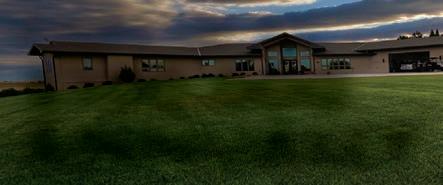




A bill introduced from Clear Creek County that would give commissioners the ability to ban the discharge of rearms in certain unincorporated areas with a certain population density passed 9-4 in the Local Government House Committee on Feb. 8.
Currently, county commissioners may not prohibit the discharge of rearms in unincorporated areas of counties in shooting galleries, on private grounds or in residences under circumstances that do not endanger people or property.
e current law says the area must have a population density of 100 people or more per square mile to prohibit shooting.
HB 23-1165 looks to repeal the exception in the current law for private property and repeal the minimum population density requirement from 100 people or more per square mile to 35 dwellings or more per square mile. is number is an amendment to the bill decided upon with collaboration between local sheri ’s departments.

e bill was presented by Rep. Judy Amabile, D-Boulder, and backed by Sen. Dylan Roberts, D and Sen. Sonya Jaquez Lewis, D. e bill itself was born out of a small community in unincorporated Clear Creek County in the Idaho Springs neighborhood St. Mary’s Glacier, which has around 300 homes, according to residents.
In spring 2021, Clear Creek County Commissioners, law enforcement and other local agencies started to get calls out of the St. Mary’s Glacier area.
Frank Brown is a homeowner
in the area. He testi ed at the rst hearing for the bill.
“As soon as the rearm discharging starts, it’s like an egregious end to all of the peace, the quiet, there’s automatic weapon re, there’s semiautomatic, and it’s so loud animals take o ,” he said.

Beth Ramsey is a part-time resident of St. Mary’s Glacier, and an experienced gun owner and user. She testi ed on Feb. 8 in support of the bill.
“We are gun owners, we are target shooters,” she said. “What we are seeing in St. Mary’s Glacier on a third-acre lot is wholly unsafe.” Ramsey recalled shooters in the neighborhood using pine trees as backstops, ring large caliber weapons.
“ ey were spraying bullets,” she said.
St. Mary’s Glacier community members reached out to Amabile to seek a bill when they saw no results from local government agencies in Clear Creek County.


Taylor Rhodes, executive director of Rocky Mountain Gun Owners, testi ed against the bill on Feb. 8, claiming it to be an attack on the Second Amendment.
“ is bill is a preemptive condemnation of all Colorado gun owners as irresponsible hooligans incapable of shooting responsibly on their property,” he said in his testimony. is bill, while inciting claims of amendment violations from gun activists, would only provide counties the option to enforce the ban on
rearm discharge in certain areas.
e Board of County Commissioners would only be able to do so after holding a notice hearing for the public within their respective counties.
“It’s a little frustrating, because the safety, or lack thereof, has nothing to do with the type of local government that serves you and everything to do with the density of the neighborhood,” Clear Creek County Commissioner George Marlin said.

e bill will now advance to the oor of the House and must pass through the legislature by mid-May to have a chance at approval by the Governor.
“Peace and safety? Everyone deserves that,” Marlin said.

CIRT investigating a death at Detention Services Division facility
The Critical Incident Response Team investigates all in-custody deaths
 BY ANDREW FRAIELI AFRAIELI@COLORADOCOMMUNITYMEDIA.COM
BY ANDREW FRAIELI AFRAIELI@COLORADOCOMMUNITYMEDIA.COM








James Jarvis was found unresponsive in his county jail cell at the Detention Services Division facility suddenly on Feb. 4 late in the evening by his cellmate. Deputies attempted “life-saving measures,” as well as calling for medical sta and the Golden Fire Department, according to the Je erson County Sheri ’s O ce. He was pronounced dead in his cell.
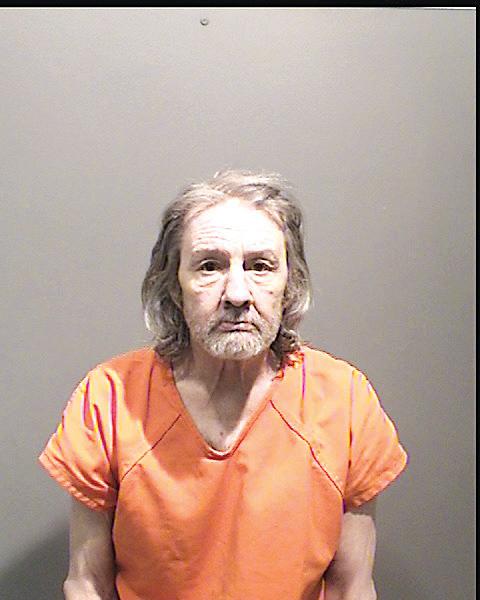
e sheri ’s o ce announced Jarvis’ death in a statement Feb. 5., marking the rst in-custody death this year. Since 2020, there have been four.

“Beginning less than two years ago, it was the consensus of the CEOs of law enforcement agencies in the First Judicial District that (the Critical Incident Response Team) shall be utilized to investigate any death of a person while under the care and control of a law enforcement o cer acting under the color of o cial law enforcement duties,” Director of Public A airs for the Colorado First Judicial District Attorney’s O ce Brionna Boatright told Colorado Community Media.
“So, for us, even in situations
involving a death where there is no reasonable belief that a law enforcement o cer engaged with or contributed to the decedent’s death, CIRT will respond and conduct an independent and thorough investigation, just as they would in a use of force situation,” she added. CIRT is currently investigating Jarvis’ death, according to Boatright.
e most recent in-custody death before Jarvis was in June of 2022, when Sierra Sandoval, 22, died while in transport to the Je co Detention Facility. e DA’s O ce ruled there was “no evidence that
law enforcement was criminally re-

Before that was the death of Rich2021. Booked for a felony domestic violence o ense, the DA’s O ce determined there was no one criminally responsible for his death. It was ruled a suicide.
About a month before that, Damion White, 26, was ruled dead also by fentanyl intoxication while in a work release program. CIRT’s investigation found no evidence that law enforcement engaged with White at the time of his death.
e fourth in-custody death was of Lasoro Aguilar on Aug. 10, 2020. Unlike the others, this situation began with Arvada Police Department o cers responding to a 911 call, according to CIRT’s report. e autopsy stated “the main, and possibly only, factor in the death of Mr. Aguilar” was methamphetamines. CIRT reports, which mainly investigate situations where ofcers used, or attempted to use, deadly force against someone, can be found on the DA O ce’s website going back to 2016. Within those reports, there are no other cases of in-custody deaths.
PUC responds to Polis’ call for utility relief




Searching for answers
BY JOSHUA PERRY THE COLORADO SUNColorado’s Public Utilities Commission on Feb. 8 discussed addressing bill price hikes in response to Gov. Jared Polis’s utility costreduction directive, but it isn’t clear what the rst steps will be.
Chairman Eric Blank said that the PUC has been tasked with a wide range of objectives to ease an affordability crisis that made consumers’ utility bills 52% higher on average in December. Some consumers saw their bills double or even triple.
“Among other things, the governor has asked us to identify ways to support customers in the most dire circumstances, improve access to and the capacity of the bill assistance program, nd ways to incentivize utilities to reduce customer costs, analyze approaches for limiting bill spikes, and to expand public engagement on these issues before the end PUC,” he said.
Blank said he didn’t know how the PUC would take action on this directive right now, but they would continue addressing a ordability in the coming weeks.
One way the PUC can make progress is driving down base rates,
Commissioner Megan Gilman said. Under the current rules, a utility seeking to add new infrastructure,
such as transmission lines or a power plant, must rst convince PUC regulators that it is necessary. If PUC agrees, it issues a certi cate of public convenience and necessity to approve the request.
Once the project is in operation, the cost of the investment is passed on to consumers through an increase in base utility rates. PUC also has the power to set a return on investment rate, which determines the pro t that utility companies get from these investments. at ROI rate can contribute to higher prices as well.
Base rates have been increasing for years. Higher base rates make periods of extreme price pressure — usually resulting from high fuel costs or unusually cold weather conditions — even worse. e PUC can’t control those factors, but they can drive base rates down in the long run by limiting unnecessary investments by utility companies, Gilman said.
“What are we doing to really try to ensure that rate-payers are protected in the long run and (ensure) that those utility investments that end up being repaid by rate-payers are really the best use of that money, and the best option available?” she said.
Blank said that managing base rates will be part of the discussion on a ordability moving forward. Later at the meeting, the commission also approved updates to its policy for service disconnection reporting, which now will include data on areas with the highest proportions of disconnections in order
to identify geographic disparities in access to utility services.

Additionally, they made plans to meet with assistance program coordinators and utility companies to improve the e ectiveness and accessibility of low-income quali ed programs.
Access to sources of assistance like the Percentage of Income Payment Program, which limits utility costs for low income families to up to 6% of their monthly income, must be improved, according to Gilman. e PUC has taken some steps already to make its process open and easy to understand, she said, but there’s still much room for growth when it comes to working in a mode that engages the public on addressing long-term a ordability moving forward.
“ is is a massive issue, to take this agency and all of the sudden try to humanize, try to improve accessibility, try to improve language access, try to improve these opportunities,” Gilman said. “By no means do we have it all gured out.”
is story is from e Colorado Sun, a journalist-owned news outlet based in Denver and covering the state. For more, and to support e Colorado Sun, visit coloradosun.com. e Colorado Sun is a partner in the Colorado News Conservancy, owner of Colorado Community Media.
TURN TO THE COLORADO SUN FOR NEWS ACROSS THE STATE
The Colorado Sun is a journalistowned, award-winning news outlet that strives to cover all of Colorado so that our state — our community — can better understand itself.

In this way, The Sun contributes to a more vibrant, informed and whole Colorado.
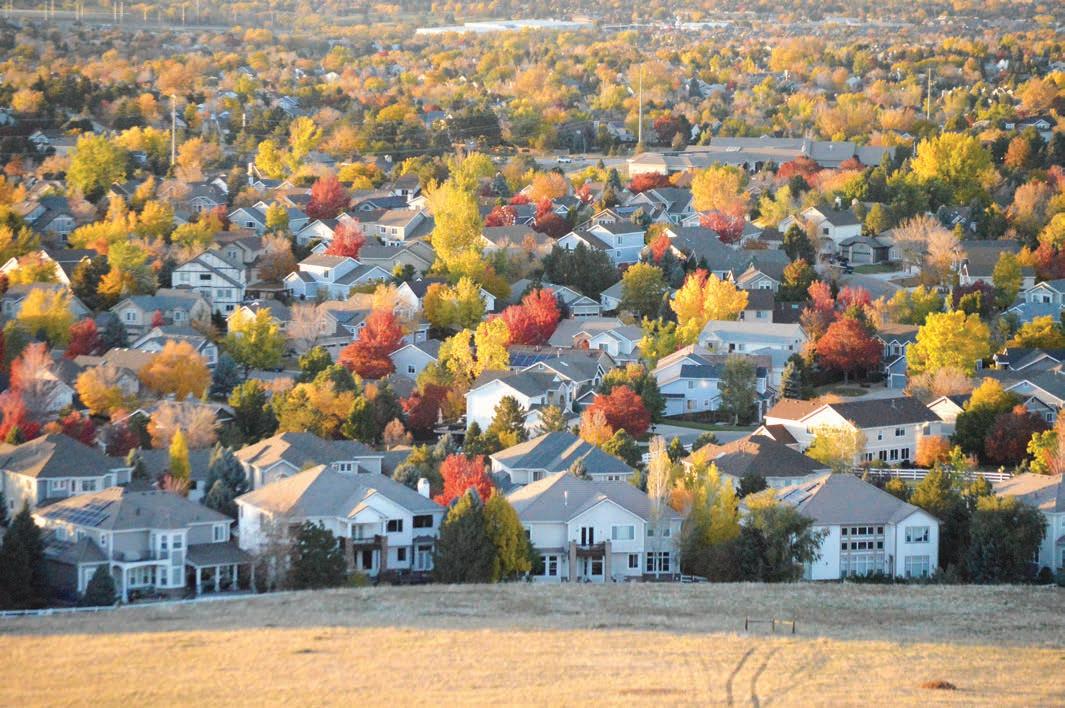
The Sun, launched in 2018, is committed to fact-based, in-depth and non-partisan journalism. It covers
everything from politics and culture to the outdoor industry and education.

Now, The Colorado Sun co-owns this and other Colorado Community Media newspapers as a partner in the Colorado News Conservancy. The Sun is CCM’s partner for statewide news. For Colorado Sun stories, opinions and more, and to support The Sun’s misssion as a member or subscriber, visit coloradosun.com.

Thu 2/23
Featured
Fri 2/24
The Reminders: Navigate Your Health Career Event
@ 8am SpringHill Suites by Marriott Denver Downtown, 1190 Auraria Pkwy, Denver

Featured
Featured
Featured
Dave Halchak @ 5pm
The Golden Mill, 1012 Ford St, Golden
Dave and Tara Powers: Worship @ Faith Church @ 10am

Faith Bible Chapel, 6250 Wright St, Arvada
Bathe @ 8pm
Globe Hall, 4483 Lo‐gan St, Denver

Wed 3/01
Brother Andrew At Goosetown Station @ 7pm
Featured
Many Mountains Live at Magnolia @ 4pm Harry's at Magnolia Hotel Denver, 818 17th St, Denver
Goosetown Station, 514 9th St, Golden
Lipgloss: An Indie Dance Party @ 9pm / $10

Ophelia's Electric Soapbox, 1215 20th St, Denver
Featured
damanithesun: HIGH‐FIVES4LOWLIVES











@ 7pm The Roxy Theater, 2549 Welton St, Denver
Mateo Mblem: Better Hope There's No God TOUR @ 7pm
The Roxy Theater, 2549 Welton St, Denver Radio Fluke @ 8pm Globe Hall, 4483 Logan St, Denver
Featured Featured
Coastless
Creatives: Coast‐less Creative Pre‐
sents: Nicki Walters and Friends @ 9:30pm

Broadway Roxy, 554 S Broadway, Denver
Sat 2/25
Paramount Theatre Club Seating: The Pink Floyd Laser Spectacular @ 8pm / $34.50
Paramount Theatre, 1621 Glenarm, Denver
Erin Stereo: 715 Club @ 10pm 715 Club, 715 E 26th Ave, Denver
Sun 2/26
Riley Green @ 7:30pm
Rodney Rice
@ 9pm The Woodcellar Bar & Grill, 1552 Bergen Pkwy #101, Evergreen
Mission Ballroom, 4242 Wynkoop St, Den‐ver

Suicide Forest with Belltower and Insipidus @ 8pm

Hi-Dive, 7 S Broad‐way, Denver
Mon 2/27
Learn To Lift M/W 3:30 Mar-Apr @ 3:30pm / $398
Feb 27th - Apr 28th
Mighty Movement Academy, 2245 Kearney St. #102, Denver. 720-955-3677
Metropolitan Jazz Orchestra @ 6:30pm
Dazzle Denver, 1512 Curtis St, Denver
Viagra Boys @ 8pm Ogden Theatre, 935 East Colfax, Denver
Tue 2/28
Kurt Travis @ 6pm / $18

Moon Room at Summit, 1902 Blake Street, Denver
Mark Masters Comedy: Mark Masters Hosts Mary Mack at LoDo Comedy Show @ 7pm

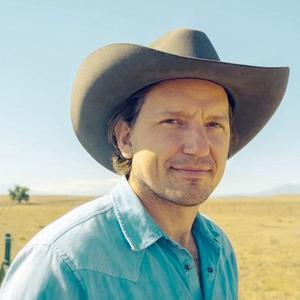
The Black Buzzard, 1624 Market St, Den‐ver
Rotting Christ @ 7:30pm
The Oriental Theater, 4335 W 44th Ave, Denver
Akiko Tsuruga @ 6:30pm

Nocturne, 1330 27th St, Denver
Featured Featured
Vinyl Williams @ 8pm Lost Lake Lounge, 3602 E Colfax Ave, Denver
Dave Abear @ 9pm So Many Roads Brewery, 918 W 1st Ave, Denver

Op-Ed: Continuing the conversation about housing
I appreciate the deep diveinto housing in our community. From my time as a case manager, working with low-income and disabled individuals, I echo many of the concerns shared in these recent stories.
As an Arvada City Councilmember, my focus has been around housing, and while I love discussions around this topic, I wanted to share two actionable ideas that I hope we can support and push forward as a community.
First, we need to build out supply of a ordable units. While a ordable housing developments take years before someone can move in, a shorter-term answer is something called a landlord guarantee (or incentive) program. is is oneway cities can help build supply: by
incentivizing new landlords to accept voucher recipients through a one-time bonus. Arvada could pay for this, or other plans should the city elect to participate in the recently passed ballot initiative Proposition 123, which provides funding for more a ordable units while also bolstering local rental assistance
Second, when someone moves into an a ordable unit with their voucher, they often stay there for years, if not decades, because it is so hard to nd another unit. Addi-
tionally, since vouchers are income based, recipients often cannot make enough income to jump from public assistance to self-sustainability. For that reason, we should support nonpro t programs that support lowincome individuals shift from public assistance to self-sustainability. One program example of a self-su ciency model is Beyond Home, located right here in Arvada. Beyond Home’s model allows families on public assistance to learn essential life skills, take job training or certi cation courses, and accrue savings so they can move into their own home without the need for a voucher. us, freeing up a ordable housing units for the next individual or family that needs it.
I know it can seem like such a
The grip of a group
Becoming and remaining part of a group is more than a choice. It is a demand of the human psyche. For all the blather about individualism, a tenet of secular American religiosity, belonging is the dominant human social gene. It is as instinctive to human behavior as walking, eating, and copulating. In fact, individualism is not part of the human social genome. It is a relatively modern idea, a philosophy, a choice birthed during the Age of Enlightenment. More than we need to belong, we want to belong. Belonging to a group fosters good mental health and social cohesion, which is requisite for survival. Unbelonging induces loneliness, which leads to despair. One of the worst punishments that can be imposed on someone for not following a group’s rules is banishment or ostracization. Whether political exile, solitary con nement, or shunning, forced separation from a group or society can cause deep distress and potentially irreparable harm. While some groups wither away, others last long after current members move away or die. Groups —
LETTER TO THE EDITOR
Homelessness in Olde Town
I believe the problem with the addicts and the homeless can be directed directly at the RTD G Line.
Its no coincidence that we started having this problem when the G Line opened. e last time I used the G
JERRY FABYANICfamilies, religions — are greater than the sum of their parts and thus hold an even more dominant grip on their members. If and when a member separates from the group, there can be hell to pay for it. at is especially true with cults.
Groups like school classes that are formed by happenstance and have a select, nite number of speci c members gradually wither away as nature takes her course. Others like the local Elks or Hotrod Club might or might not fade away when members move on. Friendship groups formed organically eventually die too.
Choosing to detach from a group can be excruciating because the group, whether social or religious, holds power over the individual, and it never likes when a member says, “Tata. Time to go.” Leaving a group is considered the worst form of heresy. A good friend posed this question
Line, with my grandkids, I couldn’t believe all the homeless people camped out at the RTD station.
e mayor and the city promised us Nirvana when the G Line opened. Everyday I see its empty train cars, even at rush hour, pass me. Now we are getting
LINDA SHAPLEY Publisher lshapley@coloradocommunitymedia.com
MICHAEL DE YOANNA Editor-in-Chief michael@coloradocommunitymedia.com
Call first: 27972 Meadow Dr., #320
Evergreen, CO 80439, 303-566-4100
Mailing Address: 750 W. Hampden Ave., Suite 225 Englewood, CO 80110
Phone: 303-566-4100
Web: ArvadaPress.com
To subscribe call 303-566-4100
daunting issue and I often hear “we don’t even know where to start.” Well, neighbors, here are two ideas that we can move forward with today! If you support either of these ideas, you can let our Arvada leadership know your support for participation in the Proposition 123 funding program or make donations to nonpro ts like Beyond Home that is doing direct work in moving people towards self-su ciency in our community.
ank you to the Arvada Press for sharing great information on such an important issue like housing. Let’s keep the conversation going.
Lisa Smith is a member of Arvada City Council. She can be reached at lsmith@arvada.org
KRISTEN FIORE West Metro Editor kfiore@coloradocommunitymedia.com
RYLEE DUNN Community Editor rdunn@coloradocommunitymedia.com
to me: “Why do we often hang on to a group after we realize that remaining part of it no longer serves a good purpose and is, therefore, not good for our social or mental health?”
en he added, “It’s the moment when you really admit something no longer works for you. It evolves slowly and you feel it coming. en you nally admit it and know it. You continue anyway because whatever it is—group, activity, people—it brought you happiness in the past. You hang on despite the payo being minimal or even negative. But you continue. Why? No good alternatives? Force of habit? Don’t want to o end? And all the time, your inner core continues to melt because you are not being true to yourself and nding new things like you used to.”
Hmm, I thought. Yes, all of those, and possibly more.
One of my favorite lms is Brokeback Mountain, a story about two young cowboys — more accurately, sheepherders — who fall passionately in love. From the outset, you have a sense, and even know, that the story will not have a happy end-
the homeless problems from Denver. e mayor now calls for action!
Where have you and the progressive city council been for the past few years? It’s now a problem? My daughter quit a job in Olde Town because of all the stealing and rambles of the
MINDY NELON Marketing Consultant mnelon@coloradocommunitymedia.com
AUDREY BROOKS Business Manager abrooks@coloradocommunitymedia.com
ERIN FRANKS Production Manager efranks@coloradocommunitymedia.com
LINDSAY NICOLETTI Operations/ Circulation Manager lnicoletti@coloradocommunitymedia.com




ing given it is set in Wyoming in the 1960s, 1970s and 1980s. ey tear at each other in frustration, but they can’t seem to end — quit — the relationship. ey are full of angst about it, and that is relatable to almost everyone, whether in the context of a one-on-one relationship or a group. Ending a relationship is di cult. I don’t have a good answer for my friend other than to say we should step back and note the power and attraction of both the groups you would like to separate from and the ones you want to stay in. en work to sort out why you want to separate from the ones you want to leave instead of focusing on the challenge of detaching. It’s like breaking an addiction. e rst step is to recognize the problem. e second step is to note the emotional attachment to it. If it doesn’t feel good, why keep doing it? at is when the power of choice come into play.
Time to move on.
Jerry Fabyanic is the author of “Sisyphus Wins” and “Food for ought: Essays on Mind and Spirit.” He lives in Georgetown.
homeless.
Now we have meth in the library. Surprise, surprise! Olde Town is becoming like downtown Denver and our politicians are always too late to solving problems.
David Albertsen, Arvada
Columnists & Guest Commentaries
Columnist opinions are not necessarily those of the Press. We welcome letters to the editor. Please include your full name, address and the best number to reach you by telephone.
Email letters to kfiore@coloradocommunitymedia.com

Deadline Wed. for the following week’s paper. To opt in or out of delivery please email us at circulation@ coloradocommunitymedia.com

The West is an exploiter’s paradise
High on a mesa where everyone can see it, a trophy house is going up in the northern Colorado valley where I live. Some of my neighbors hear that the house will be as big as 15,000 square feet. Others say it will take three years to complete. Whether that is valley gossip or truth, the house is now the center of everybody’s attention.
Until this happened, my valley seemed to o er much of the best of what Colorado has to o er, including views of a snow-capped mountain range, and spread out below, irrigated hay elds with black cows on tan rangeland. But now, right in the center of the valley, will be one person acting out a lack of consideration for others.
Gigantic trophy houses seem to signal, “I built here to see, but also to be seen.” It’s a jarring reminder that we in the New West are remaking the Old West in our own image, a job that apparently requires a drastic redoing of topography.
ese big homes seem to follow a pattern of complicated roo ines, lots of windows that re ect the light and “ego gates” at the beginning of

ABOUT LETTERS TO THE EDITOR
Colorado Community Media welcomes letters to the editor. Please note the following rules:
• Email your letter to kfiore@coloradocommunitymedia.com. Do not send via postal mail. Put the words “letter to the editor” in the email subject line.



• Submit your letter by 5 p.m. on Wednesday in order to have it considered for publication in the following week’s newspaper.
• Letters must be no longer than 400 words.
• Letters should be exclusively submitted to Colorado Community Media and should not submitted to other outlets or previously posted on websites or social media. Submitted letters become the property of CCM and should not be republished elsewhere.
• Letters advocating for a political candidate should focus on that candidate’s qualifications for office. We cannot publish letters that contain unverified negative information about a candidate’s opponent. Letters advocating for or against a political candidate or ballot issue will not be published within 12 days of an
WRITERS ON THE RANGE
driveways.
Proclaiming Christ from the Mountains to the Plains www.StJoanArvada.org
12735 W 58th Ave · 80002 · 303-420-1232
Daily Masses: 8:30am, Mon-Sat
Confessions: 8am Tue-Fri; 7:30am & 4:00pm Sat
Saturday Vigil Mass: 5:00pm
Sunday Masses: 7:30, 9:00, 11:30am, 5:30pm
Richard KnightMost of us in this valley delight in what we’ve been able to see from our front door: Uninterrupted ridgelines, cli s, and the rounded slopes that converge to make foothills, which then rise into mountains. Nature made these views, and we’ve been fortunate to have them in our lives every day.
But more and more, houses that resemble castles are sprouting on ridgelines and hilltops, here and all over the mountains. And sometimes it’s ordinary houses or trailers that get built on ridgelines, interrupting the natural ow of the land.
Where only a few years ago our eyes might nd comfort in tracing a ridge’s backbone — wondering how it got to be named White Pine Mountain when no white pines grow there — now we look at manmade structures that irritate the eyes.
People who have lived in my valley
election.
• Publication of any given letter is at our discretion. Letters are published as space is available.
• We will edit letters for clarity, grammar, punctuation and length and write headlines (titles) for letters at our discretion.
• Please don’t send us more than one letter per month. First priority for publication will be given to writers who have not submitted letters to us recently.
• Submit your letter in a Word document or in the body of an email. No PDFs or Google Docs, please.
• Include your full name, address and phone number. We will publish only your name and city or town of residence, but all of the information requested is needed for us to verify you are who you say you are.

• Letters will be considered only from people living in Colorado Community Media’s circulation area in Adams, Arapahoe, Clear Creek, Denver, Douglas, Elbert, Jefferson and Weld counties.
• Do not use all caps, italics or bold text.
for decades share a di erent style. Appreciating what a winter wind can do to steal warmth from inside a house, they looked for sheltered areas to build. ey saw it made sense to build low, tucking a home against the south side of a hill or cli .
Most yard lights were few and hard to see, as were their homes. But the new Western lifestyle broadcasts yard lights at night for all to see, just as the homes are conspicuously visible during the day.
In this newfangled West that has “ranched the view,” people apparently need to stand out to enjoy an amenity lifestyle. Will these new folk ever take time to appreciate the human and natural histories of the place they live in now, to show respect for the land and its natural beauty? Will they learn to be considerate of neighbors and not take away from the views that de ne where we live?
It’s shameful to think that just as we rst moved into the West to exploit its valuable resources, we now exploit the last resource our region has to o er — its heart-stopping beauty.
ere is some good news, because
GOLDEN – Henry “Duke” Smith died peacefully on February 1, 2023 following a long illness. He was born March 30, 1937 in Lawrence, KS, the second of four children, to Henry Smith and Ruth (Watson) Smith. He was predeceased by his parents and three siblings.
He graduated from Lawrence High School in 1955 and attended the University of Kansas where he studied engineering and played varsity baseball. After playing a short time for the Oklahoma City Indians, his pursuit of a professional baseball career ended in injury.
Duke married the love of his life, eresa (Byers) in 1959 and the couple settled in Lawrence, KS, where, following in the footsteps of his grandfather, he became a police o cer with the Lawrence, KS Police Department. e couple welcomed a daughter, Sharon, in 1960 and a son, Duane, in 1962.
Duke held positions in both the Lawrence, KS and Kansas City, MO Police Departments between 1962 and 1966, but during a trip to Colorado in 1966 he and his wife fell in love with the state and decided to make Colorado their permanent home.
He was hired in 1966 as a patrolman for the City of Edgewater, launching a groundbreaking career of service and leadership that would span a quarter century.
in many parts of the West we are learning how to sustainably log, graze, divert water and develop energy. I hope it’s not too late for us to also realize the value of tting into the land as residents, to keep intact our ridgelines, mesas, mountains and valley oors. Once a house caps a hilltop, however, that view is irretrievable, gone forever.
I hope we can learn how to value homes that blend with the land in shape, color and location. Maybe a new generation of home builders, architects, and developers will lead the way in paying due respect to our region’s natural beauty.
But I’m afraid that it’s too late for our valley. e great writer Wallace Stegner told us that the task of Westerners was to build a society to match the scenery. From what I see, we’re not doing the job.
Richard Knight is a contributor to Writers on the Range, writersontherange.org, an independent nonpro t that hopes to inspire lively conversation about the West. He works at the intersection of land use and land health in the American West.

He was appointed Chief in 1979, making history as the rst AfricanAmerican police chief in the state of Colorado. He retired in 1991 and was the longest tenured law enforcement o cer in Edgewater’s history.

In October ‘91 he was appointed by Governor Roy Romer and the Colorado Department of Transportation to spearhead “Operation Buckle Down” a nationallyfunded seat belt campaign whose purpose was to educate and save lives. He served until 2006, working with law enforcement agencies throughout the state.
Duke lived life to the fullest, pursuing his hobbies and life interests with the same zeal and commitment he was known for in his professional life. He was an avid tennis player, award-winning photographer, pilot, and world traveler, whose favorite city was Paris, France. He loved gardening and adored spending time with his three grandchildren.
Duke is survived by his wife of 63 years, eresa Smith, children Sharon SmithMauney (Leonard) and Duane Smith, and grandchildren Kyle Mauney, Mariah Smith and Bronson Smith.
Memorial service, Saturday, 2/18, 11am at Edgewater United Methodist Church. In lieu of owers donations may be made to e Denver Hospice, 8289 E. Lowry Blvd., Denver, CO 80230

While working out at a gym in Golden recently, someone approached Ty Scrable and asked if he was associated with Colorado School of Mines. Scrable had to explain that, no, he’s just a Golden resident.
Unfortunately, Scrable said, this isn’t the rst time it’s happened.
“I get that a lot,” he said. “People think I’m a student, professor or tourist because I’m Black.”

Systemic racism stubbornly remains in Golden. But, as Scrable said, it has morphed from Ku Klux Klan demonstrations in the 1920s and racist housing policies in the 1940s to something less overt but still widespread and endlessly frustrating.
Because White people make up the overwhelming majority in the city and, thus, are seen as the norm, Scrable said, “many people don’t view me as part of my own community.”
In the wake of Black Lives Matter demonstrations in the summer of 2020, many cities and newspapers across the United States have started reckoning with their pasts, examining how they’ve contributed to systemic racism, learning what they can do to be more inclusive and fair. e Golden community has started the process, and now it’s the Golden Transcript’s turn.

e newspaper, which now is part of Colorado Community Media, isn’t immune to biased coverage. is report is the product of its journalists attempting to examine the paper’s coverage of the Black community since the Civil Rights era and own up to its mistakes.

Since 1866, the Golden Transcript — known as the Colorado Transcript for its rst 103 years — has been a record keeper for Je erson County. While its stories are extensive and valuable, the paper contains original and reprinted content that was harmful to the Black community and other marginalized groups.
Just one example is its coverage of the Black Panther Party, a group that gained national attention in the late 1960s for its response to policing in Black communities across the country.


Between 1969-1971, the newspaper published approximately 170 articles that referenced the Black Panther Party. Nearly all of these articles
BEYOND THE GOLDEN TRANSCRIPT: Our efforts to reconcile racial mistrust begins with this story
In our newspaper this week, you’ll see an article about the Golden Transcript. It’s one of two dozen newspapers owned by Colorado Community Media, which also owns this paper. The article tackles the issue of systemic racism in the Transcript’s pages.

The idea for the project started in 2020, when the Colorado News Collaborative, Colorado Media Project and Free Press convened the Black Voices Working Group, which was made up of Black leaders, community members and journalists. The group addressed media coverage and focused on how to improve trust in mainstream media among the Black community. Acknowledging past harm was the No. 1 recommendation made by the group.
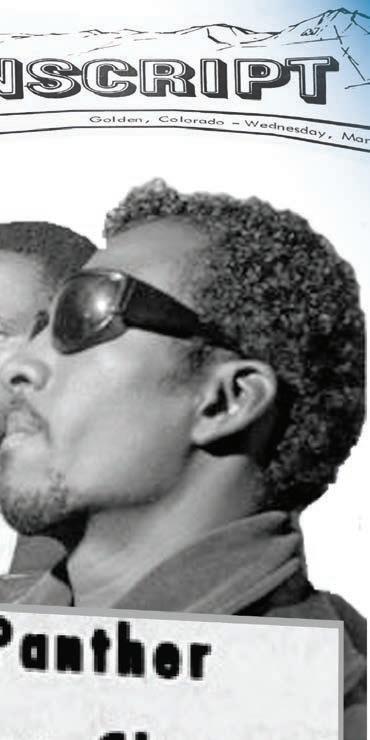
A few months later, I attended a Denver Press Club event where Jameka Lewis, a senior librarian at the BlairCaldwell African American Research Library, illustrated biases in mainstream local media coverage of the Black Panther Party in the 1960s and ’70s while exhibiting rare prints of the Black Panther Press. Many of Lewis’ examples came from the Transcript. Most articles were wire stories from
other cities, but editors still chose to run them, affecting perceptions of the party in Golden.
We pursued and were awarded a grant from the nonpartisan Colorado Media Project to explore, uncover and analyze this issue in the form of the special report that is in this edition of your newspaper.
Our newsroom, which is predominantly White, also participated in the Maynard Institute’s diversity, equity and inclusion Fault Lines training along the way. West metro editor Kristen Fiore was a speaker at the Advancing Equity in Local News convening with journalists from publications like the Philadelphia Inquirer and the Washington Post to talk about this project.
We believe this story is important beyond Golden — and we hope to spark conversations in our communities across the Denver area about race and inclusion and how our news coverage impacts those issues.
Linda Carpio Shapley is publisher of Colorado Community Media, which runs two dozen weekly and monthly publications in eight counties. She can be reached at lshapley@coloradocommunitymedia.com

presented the group in a negative light, with words such as “fugitive,” “thugs” and “militants.” And, the Transcript appeared to rarely cover the Black community in the city and wider region. Because of this, their voices are missing in archives, now online as an important chronicling of Colorado’s history.
By not including these voices in an accurate light, and by publishing stories that reinforced harmful stereotypes and/or recorded Black people’s traumatic experiences in an apathetic or ippant way, the Golden Transcript’s coverage contributed to systemic racism, according to researchers and Black community leaders.
Jameka Lewis, senior librarian at the Denver Public Library’s Blair-Caldwell African American Research Library and a freelance researcher on this report, said Transcript readers may have had their beliefs about the Black Panther Party, and the Black community in general, shaped by the Transcript’s negative portrayals.
“ ere is harm when it comes to media and the Black community in Denver and Colorado,” Lewis said. “If we want to repair the harms, we have to acknowledge that (they are) factual.”
Alfonzo Porter, editor-in-chief at Denver Urban Spectrum and a journalism professor at Metropolitan State University of Denver, said mass media has been at the epicenter of “propagating negative images and re ections of the AfricanAmerican community.”
“It really stems out of our country’s background, and we’re still dealing with those biases,” he said.
While almost all of the Transcript’s stories about the Black Panther Party were from wire services like United Press International, Porter said the Transcript and other newspapers are accountable for reprinting those stories.
“It’s exactly like original reporting, because … the editorial sta sat in a room, looked at this piece, determined that it was appropriate and ran with it in the paper,” he said.
The Black Panther Party
e Black Panther Party for Self Defense started in 1966 in Oakland, California. Founders Huey P. Newton and Bobby Seale started the organization as a response to police brutality there and in other Black communities, according to Lewis’ research.
e party had a 10-point program that included demands for Black liberation and societal
THE COVERAGE
How national, Denver-area papers covered the party Sisters Ida Daniel, Pat Rogers and JoEllen Greenwood grew up in Denver and graduated from East High School in the ’60s and early ’70s. ey recalled reading e Denver Post and Rocky Mountain News and watching the nightly news on TV. ey also listened to the city’s Black radio station, KDKO, and read Black-oriented magazines like Ebony and Jet.
Overall, the three didn’t recall a lot of news stories about Black people in the mainstream press, unless it was negative. e news covered Black people who were arrested for murder, robbery, rioting and other crimes. Rogers summarized the coverage as: “Be afraid of Black people.” at kind of coverage played out with the Black Panthers. In 2016, e New York Times analyzed stories about the Panthers, noting “journalists were at once fascinated and frightened by them” and their activities in the 1960s and ‘70s. Coverage about the Denver Panthers in Black newspapers in the area at the time was scant. Of those Lewis researched, the Black-owned publication e Denver Blade published the most articles on the group’s activities, both locally and nationally, in 1969.
Its coverage appears to be fairly balanced, Lewis said.
One Blade article discussed the Panthers’ orga-
improvement. Eventually, the Black Panthers led more than 35 community programs across the country, like the Free Breakfast for School Children Program — also known as e Free People’s Food Program, which helped feed Black children from economically disadvantaged families.
In Denver, a chapter gained recognition in 1967. Led by Lauren Watson, the chapter’s history was largely erased or ignored, Lewis said, adding that the Denver Panthers were instrumental in the ght for civil rights in Colorado.

It’s important to note that many Black community members both then and now have mixed feelings about the Panthers and their work, Lewis stressed.
Longtime Denver residents she interviewed formed their opinions largely based on what they read about the Black Panthers in newspapers and saw on TV. Yet that coverage contrasts with what many in the community saw the Denver Black Panthers doing. ey were involved in school board and City Council meetings, provided free meals for children, and worked to
nizing a meeting to discuss policing and police presence at Cole Jr. High School in Denver’s diverse Whittier neighborhood. It chronicled the Black community’s e orts to address a racial gap between teachers and Black students. One possible solution, and likely at the suggestion of the Denver Black Panthers, was to establish Cole as a Freedom School, a concept that focused on Black pride and Black liberation in academics.
In contrast, the Denver Post also covered the meeting but didn’t mention the Panthers’ involvement in organizing the event or the Freedom School proposal. In a review of Post archives, the story focused on arrests. e Denver Blade coverage did not mention any Black Panther arrests.
“Oftentimes, it was up to Black news media to cover this group in a more comprehensive way, which I believe e Denver Blade did,” Lewis said. “It covered all aspects of the local and national Panthers, and o ered readers a more balanced view of the members of this group.”
e Denver Blade stopped operating in 1970.
How Golden’s newspapers covered the Panthers
e Transcript published approximately 170 articles that used the terms “Black Panther” or “Black Panthers” between 1969-1971. Almost all of these were reprinted stories from wire services, which seldom described anything positive about the party or its members.
improve the welfare of their neighborhoods and its residents.
“Many Black people believed what the media said about the Panthers,” said Terry Nelson, a lifelong member of the Denver community. “ … It depended on the source. We recognized that the newspapers weren’t telling the truth about the members. … We knew that the Denver members were active in schools, speaking with teachers and parents. We never saw that in the major newspapers.”
Tracie Keesee, a former Denver police captain and co-founder of the Center for Policing Equity, described how during this tumultuous period, the press played into the hands of government o cials.
Newsrooms considered police as trustworthy and well-respected sources, so it was easy for them to hand reporters a story and have it taken at face value, Keesee said.
Keesee added: “We see it now, right? at divisiveness in the media, the stories that are being told — or not being told.”
e only article referencing the party’s free breakfast program was published April 30, 1970, about Baltimore police rounding up Black Panthers suspected of killing a patrolman. After searching party headquarters, police searched a school where it conducted its breakfast program, among other locations.
In contrast, the Colorado School of Mines student paper, e Oredigger, published at least two stories about the Black Panther Party. Both were straightforward accounts of Lauren Watson, the head of the Denver chapter, visiting Golden.
Ultimately, while coverage of the Black Panthers varied by publication, the Golden Transcript failed to cover the party’s community initiatives or involvement. It did, however, print dozens of wire stories about the party’s supposed criminal activity and police raids associated with the group.
e coverage used negative language to describe the Panthers, their neighborhoods and any activities they were involved in. Because of this, Golden-area residents absorbed and believed what they heard and saw in the news coverage, Lewis stated.
e role of the press in forwarding racial inequality really shouldn’t be a surprise to anyone, Keesee said, especially to communities of color.
“It’s not just that person that wrote the story,
FOR THE RECORD
that person had an editor, right?

ere wasn’t anything in that editor’s mind that said, ‘Yeah…this seems a little biased. Did you even go into the community, or did you just take that o the wire and repeat it?’”

ere’s no excuse for sloppy journalism, as it is harmful and contributes directly to a larger narrative, Keesee said.
“When you talk about media coverage, there were only three channels on the television, back then; there was no social media,” she said, adding, “the newspapers were cranking out those stories overnight and you were waiting for your morning paper. Nobody was up waiting for breaking news. So, the news that was coming out, it was more focused and easier to control.”
And when news was breaking, “it
THE COMMUNITY
Golden in the 1960s and ’70s
Built on lands traditionally inhabited by the Cheyenne, Arapaho, Ute and other tribes, Golden City was founded in 1859. According to Allan Tellis, a doctoral student of political science at the University of Colorado-Boulder and freelance researcher on this report, Golden has never had a signi cant Black population.
Census data from 1960 shows that the Golden division of Je erson County had 28 Black residents. By 1970, that number had increased to 86. Overall, those numbers represent 0.15% and 0.27% of the total population, respectively, according to Tellis.
As of 2020, Golden had 388 Black residents, representing 1.9% of the city’s population.
Longtime Golden residents recalled how many of the city’s Black residents in the late 1960s and early ’70s were associated with Colorado School of Mines as students, professors or their family members. As far as discussions about the Black Panther Party speci cally or race relations in general, longtime White residents said the topic didn’t come up much because there wasn’t a large Black population in the area.
Rick Gardner, a resident who has studied Golden’s history extensively, said the community had “other preoccupations at the time,” such as labor clashes at the Coors brewery and the Vietnam War.
John Akal, a longtime Goldenite and current columnist for the Transcript, described how he spent his summers in Chicago, where it was “a whole di erent situation.” Because of the 1968 Chicago riots, which were sparked by the assassination of the Rev. Martin Luther King, Jr., Akal remembered a lot of racial tension in the city at the time.
But that was Chicago. Golden was di erent, but not necessarily better.
The KKK in Golden Overt discrimination in Golden against Black people and other

was breaking only one way, and those narratives were pretty narrow,” she added.
The newsroom
During this timeframe, the Transcript was a daily paper with a small sta of six and a wire service that provided regional and national news.
Neil Paulson, who was managing editor from 1970-75, said the paper relied on United Press International reports to cover many issues, including the Black Panthers.
“It was a terrible service, especially for a small paper,” he said. “It cost us a little more, but eventually we went to e Associated Press.”
e only dictate from the paper’s owners, e Kansas City Star and the Great (Kansas) Tribune, was to run a local story on the front page, Paulson said. National and regional stories ran inside.
Paulson noted that Golden’s population at the time, as it is today, was
communities peaked with the Ku Klux Klan, which had a strong presence in the city and throughout Colorado, particularly in the 1920s.
e Klan began in Denver in 1921 and eventually “all but took possession of the state of Colorado,” according to a report in the Steamboat Pilot. Klan members throughout Denver gathered on Golden’s South Table Mountain for cross-burnings and other rituals. According to Golden History, the mountain could attract up to 10,000 members.
Overall, the Klan helped prevent or deter unknown numbers of Black people from carving out lives in the area. History Colorado recently released ledgers of KKK membership that show seven members of the terrorist organization resided in the Golden area, Tellis added.
Racist housing policies, practices
While the Klan’s activities are certainly one reason Golden has a small Black population, it’s not the only reason. Discriminatory housing practices also contributed.
Don Cameron, a former Jefferson County teacher and current Golden city councilor, has researched zoning history and discriminatory housing policies and practices, including some accounts recorded in the Transcript.
While many Black residents in Denver were constricted by redlining, their counterparts in Golden faced other challenges.
“Starting in the ’20s and into the ’40s, it was common for people to say that they would only sell their individual property to those of the Caucasian race, or non-Negro race individuals,” Cameron stated in a self-published article about Golden’s zoning history.
“ e courts backed up this right because they were protecting the homeowners’ use of their land and had no civic duty to prevent this discrimination,” the article continues. “Blacks were excluded from being shown properties in these restrictive neighborhoods, and if they tried to purchase them, (they) might have it taken away soon
predominantly White.
He knew two Black Goldenites during his years as editor. One was Monroe Jordan, an assistant chef at downtown Golden’s historic Holland House, who later worked at the nearby Ace-Hi Tavern.
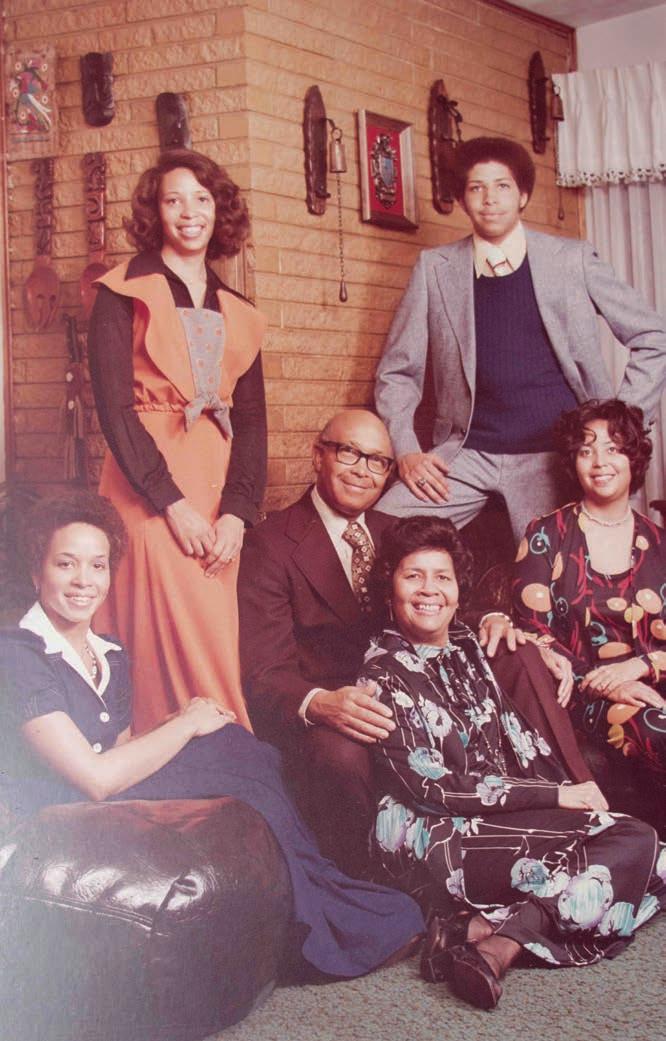
When Jordan died, Paulson ran a story on the front page that brie y memorialized him but mostly discussed an attempt to nd his relatives, as no one had come forward to claim Jordan’s body nearly two weeks after his death.
Readers didn’t react positively to the front-page piece.
“I got a couple of nasty phone calls, but no one admitted to their bias,” Paulson said. “ ey refused to apologize, of course. ey said I shouldn’t have put that on the front page. In typical Golden fashion, there was nothing speci c, other than to say, ‘You shouldn’t have done that.’ e thought of another race didn’t exist.”
For the Transcript’s newsroom, Paulson said there was no “codi ed
policy on racism” during his time there.
“We condemned it, but we made little e ort to actively attack it,” he said. “( e) Black Panthers seem remote from Golden, where there were few Black families.”
One place where Paulson thought racism showed up was on the editorial page. e paper had four syndicated columnists every day who lived outside the community. ey were selected by the publisher because “they were cheap and not already being published by the two Denver dailies,” he stated.
Paulson said he had no doubt the paper could be accused of racism for its coverage in those days.
“But I’d like to think it was by omission rather than intent,” he said. “We rarely spoke of racism and did little to come out against its pernicious e ects. I don’t remember anyone on the sta making racist remarks, and I think I would have remembered that.”
after.”
Perhaps the most evident example of this was in 1942, when Logus Butler and Susie A. Allison paid $1,500 for 30 acres near present-day Boyd Street in north Golden. ey planned to build on it, but they were forced to sell a few months later after Golden residents drove them out.
“A large number of citizens appeared before the City Council
Wednesday evening,” the Transcript reported Oct. 22, 1942, “and stated that a group of colored people had taken possession of the land recently purchased by them east of the Clark’s Garden addition, within the city limits of Golden, and were apparently staking out some building sites.”
After Butler and Allison were
FOR THE RECORD
forced to sell the land, plots on the same land were listed for sale two
THE IMPACT
In the community
While growing up in Denver in the ’60s and ’70s, Daniel and her sisters used their education and life experiences to help them decipher which news stories were biased and which were reputable. ey also relied on family and friends’ advice.
“I don’t think news at the time covered Blacks in the world that they lived in,” Daniel said. “To me, the general stories about how Blacks lived, what they did, what their concerns were and some of their needs, were not covered.”
The sisters felt this trend in coverage didn’t change until the ’80s, when news about Black people and Black communities became more prominent.
As an example, Daniel described how The Denver Post did a feature article on her late husband, Wiley Y. Daniel, who was a prominent attorney and
THE FUTURE For Goldenites
In more recent years, especially in the wake of George Floyd’s murder and the Black Lives Matter rallies in the summer of 2020, the Golden community has started examining the long reach of systemic racism in and around the city. e City of Golden started work on its Racial Equity, Diversity and Inclusion Action Plan, and groups like Golden United and Golden Anti-Racism Collective formed.
While these are good rst steps, real change has to start with people’s attitudes, GAC members Scrable and Michele Minihane said.
Although many Goldenites are open-minded and inclusive, Minihane personally believed there are still some residents who “do not value an integrated community and don’t feel like it’s important to make people of color feel welcome.”
She added: “I don’t get the sense that (attitudes) have changed a lot in 40 or 50 years.”
Scrable agreed that tangible changes, whether in attitudes or policies, have been slow. He said it’s going to take time and everyone working together to make Golden a more welcoming and inclusive place.
e two described how the Golden Anti-Racism Collective has become a place where people can share their experiences, examine systemic racism’s impact on the community, and nd ways to improve Golden for current and future generations.
As of last month, GAC has about
years later. Ownership was restricted to “members of the Caucasian race.”
ese accounts are just glimpses of Golden’s treatment of people of color, but Tellis emphasized how they demonstrate “institutionalized
the state’s first Black U.S. district court judge. She also recalled how e Post’s society section ran pictures of positive stories happening in the Black community.
“I do think it began to change in the ’80s,” Daniel continued. “ ere were positive stories (but) … the stereotypes were still going on.”
Diversity in the newsroom also seemed to improve during this timeframe, the sisters said. They recalled Reynelda Muse, the first Black person to anchor a newscast in Colorado, and Bertha Lynn, who started in Denver television in 1976.
While a lot has changed in how traditional outlets cover Black people and Black communities, the sisters believe there’s still plenty of bias. Rogers admitted that she avoids local news because there are still more negative stories about Black people than positive ones.
“I think there absolutely still is biased coverage,” she said. “I don’t want, every day, to hear
400 members on an email list and a few dozen who come to its regular meetings. ere are several subgroups within the Golden Anti-Racism Collective that tackle di erent topics such as policy and policing, education, and books and media.
While the bulk of the members are White, any Goldenites of color are welcome to join and participate as they’re able, the members said.
e group has established a unique partnership with the Golden Police Department, as some of its members sit on the department’s community engagement group, GAC member Sandra Knecht explained. GAC and other community members have given feedback on various department policies, particularly around use of force.
GAC members also try to comment on City Council discussions and participate in other local matters, including education, youth outreach and a ordable housing. In doing so, the group has developed partnerships with Shelton Elementary, the Golden Library, Colorado School of Mines student groups, Golden United and other groups that share GAC’s goals.
Similar to GAC, Golden United formed after the 2016 election as “there was a fair amount of division, nationally and locally,” Ronnie Rosenbaum said. e group sought to bring people together and encourage respect for those who have di erent ideas and opinions.
Rosenbaum, who’s vice president on Golden United’s board of directors, described the partnership between Golden United and
anti-Black behaviors and norms” in the area. So, he said, it’s no surprise that the Black Panther Party, an organization that “unapologetically called for Black liberation and the dismantling of White supremacist power structures, would catch the
about, ‘there’s another Black person who got in trouble.’”
In the country
Going back through American history, the Urban Spectrum’s Porter described other incidents where media outlets didn’t give Black people the bene t of the doubt. He listed the 1921 Tulsa Race Massacre and the Emmett Till lynching as examples of the media portraying those involved as “guilty until proven innocent,” adding how the trend has persisted into today’s coverage of police shootings and similar incidents.
“And it seems as though that mentality continues to manifest in those organizations in their treatment of our community,” he said. “And so, it’s always the bad news. ere’s really never any positive re ections.”
Regarding news coverage of the Black Panther Party, the journalism professor described it as a peaceful organization that was responding to violence “against
GAC, saying the two groups and others joined forces for a rally in summer 2020 and pushed City Council to approve the “Golden Stands with Black Lives” banner on Washington Avenue.
Minihane stressed how the GAC believes systemic racism impacts all Golden residents, regardless of race, and recommended locals read “ e Sum of Us” by Heather McGhee to learn more about that impact.
For the City of Golden
In summer 2020, the Golden City Council produced a series of resolutions meant to address its history of racial exclusion and racist domination of non-White groups, Tellis stated. ese resolutions included: Resolution 2736 – Declaring Racism a Public Health Crisis
Resolution 2747 - Declaring Support for Black Lives and Racial Equity rough a Public Display, and
Resolution 2748 - Declaring A Commitment to Anti-Racism Actions
Resolution 2736 states, “the Golden City Council recognizes that racial inequities have become institutionalized in the policies and practices of many agencies, governmental and otherwise. Council recognizes the need to examine seemingly neutral policies and practices to determine whether they are contributing to inequity and, where needed, change or eliminate the policy or practice as cities have a long history of decision and policy making that have resulted in classist and racist outcomes.”
Building on that, the city hired
ire of local reporting.”
Tellis added: “Golden has displayed a deep commitment to the marginalization of Black people.
To re ect on this legacy is pivotal if we desire to not replicate the racial strife and injustice of our past.”
African-American people in an attempt to say, ‘We will protect our community.’”
“ e idea was that Black folks with guns clearly scared the hell out of people,” Porter continued. “Because obviously, if you’ve got a gun, then you’re going to be violent. And it’s only that mentality because of our profession (as journalists). Our profession has continued to promote that re ection — still does, to this day.”
As for Golden and the Transcript’s coverage of the Black community, Porter believed it likely made Black residents feel unsafe and unwelcome, saying, “ ey know that any coverage of them will not be balanced and fair.”
Fairness and racial equity are concepts Golden, Denver, the United States and journalism as a profession need to work on, he stated.
“I don’t see our profession doing enough work in that area,” Porter said. “I hear the talk. But I’m not seeing anything to back it up.”
a consultant in June 2021 to develop a Racial Equity, Diversity and Inclusion Action Plan based on community input. After developing it for more than a year, the plan outlined four goals:
Create a culture of inclusion and belonging throughout the community of Golden; Increase access to services and resources for diverse community members;
Foster an organizational culture and environment within the City of Golden that’s committed to racial equity, diversity and inclusion; and Expand economic opportunities for diverse businesses.
Along with the REDI Action Plan, the consultants also recommended dozens of strategies toward these goals and an implementation plan.
For instance, public documents and other information should be available to those who don’t speak English or have different abilities. City boards and commissions should have a more inclusive recruiting process to ensure diversity among their members. The city also should host training about Golden’s history, structural racism and implicit bias.
The City Council adopted the REDI Action Plan in December 2022 and called on the community to ensure Golden achieves the four goals in a timely, effective way.
The plan was developed with race as the leading element because of how widespread and
Arvada West boys basketball escapes with win over Chatfield
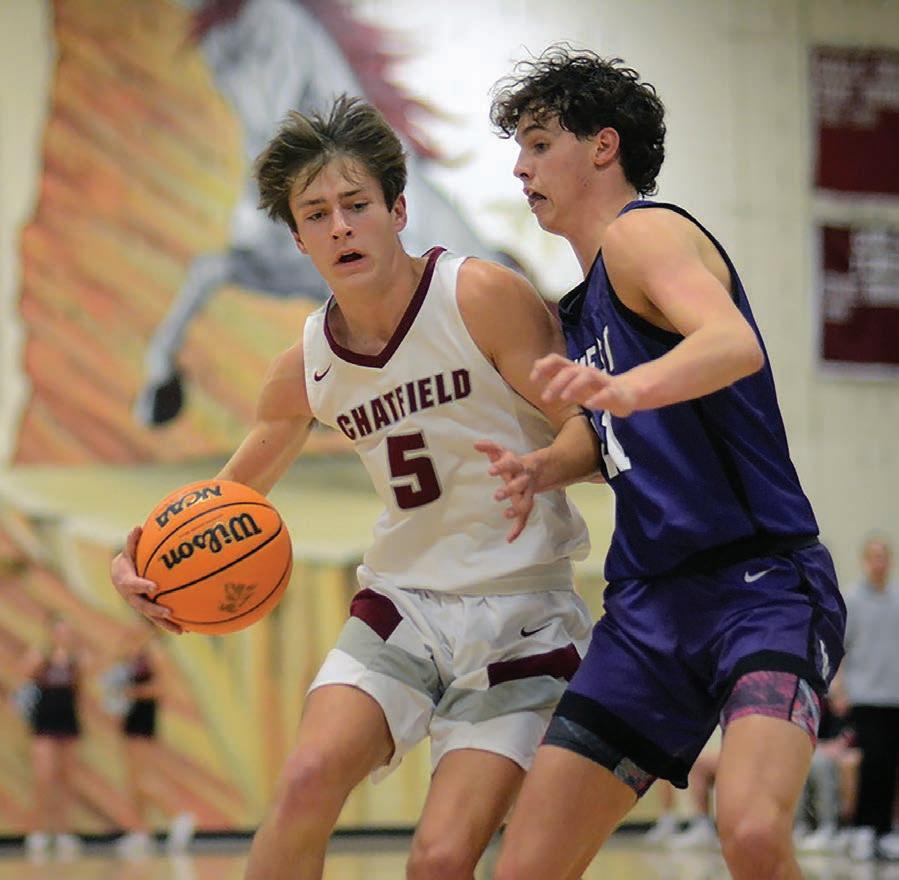 BY DENNIS PLEUSS JEFFCO PUBLIC SCHOOLS
BY DENNIS PLEUSS JEFFCO PUBLIC SCHOOLS
LITTLETON — e race for the Class 6A Je co League boys basketball title turned into a three-team race.
Valor Christian (14-7, 9-1 in league), Ralston Valley (15-6, 7-3) and Arvada West (15-7, 7-4) had distanced themselves from the rest of the eld with less than two weeks remaining in the regular season. However, things did get a little clearer last week.
Valor — No. 9 in the 6A CHSAANow. com rankings — took a big 82-63 home win Feb. 7 over Ralston Valley to take a 2-game advantage over the Mustangs.

A-West stayed right in the mix with a tight 61-58 road victory against Chateld on Feb. 7. e Wildcats hung on to the win after Chat eld junior Liam McGuire’s 3-pointer at the buzzer that would have forced overtime was just short.
“It’s good to get out of here with a win playing like we did,” A-West coach Je Parriott said. “I don’t think we were looking ahead to ursday, but they are kids. at might have been in the case. We walked out with a win and focus on ursday.”
A-West had its huge rematch against Valor on Feb. 9 back on the Wildcats’ home court. A-West handed Valor its lone conference lost Jan. 23. A sweep of Valor would give A-West the all important tiebreaker over the Eagles if both nish with the same conference record.
“We’ve got something to play for when it comes to a league championship and something to play for when it comes to seeding when we get to the postseason,” Parriott said. “We will turn it around.”
Valor was the one turning things around Feb. 9. e Eagles dominated A-West to take a 75-46 victory.
e Wildcats’ last conference title was back in the 2017-18 season when A-West o cially shared the league title with Columbine. Valor won the 5A league title back in 2020-21 and Ralston Valley captured the conference championship last year going undefeated in 5A Je co League play.
A-Wests then su ered a 61-34 loss to Bear Creek on Feb. 11 that ended any hopes for a conference title.
Before the 2-game losing streak, Nichols led A-West with 21 points, including going 4-for-4 from the free-throw line in the nal minute against Chat eld. Senior Zion omas scored just 4 points, but was also money in the nal minutes going 4-for-4 from the charity stripe.
Senior Jasper Padia had a quiet rst three quarter that included some early foul trouble, but the Wildcats’ leading scored poured in 7 points in the fourth quarter to nish with 13 points.
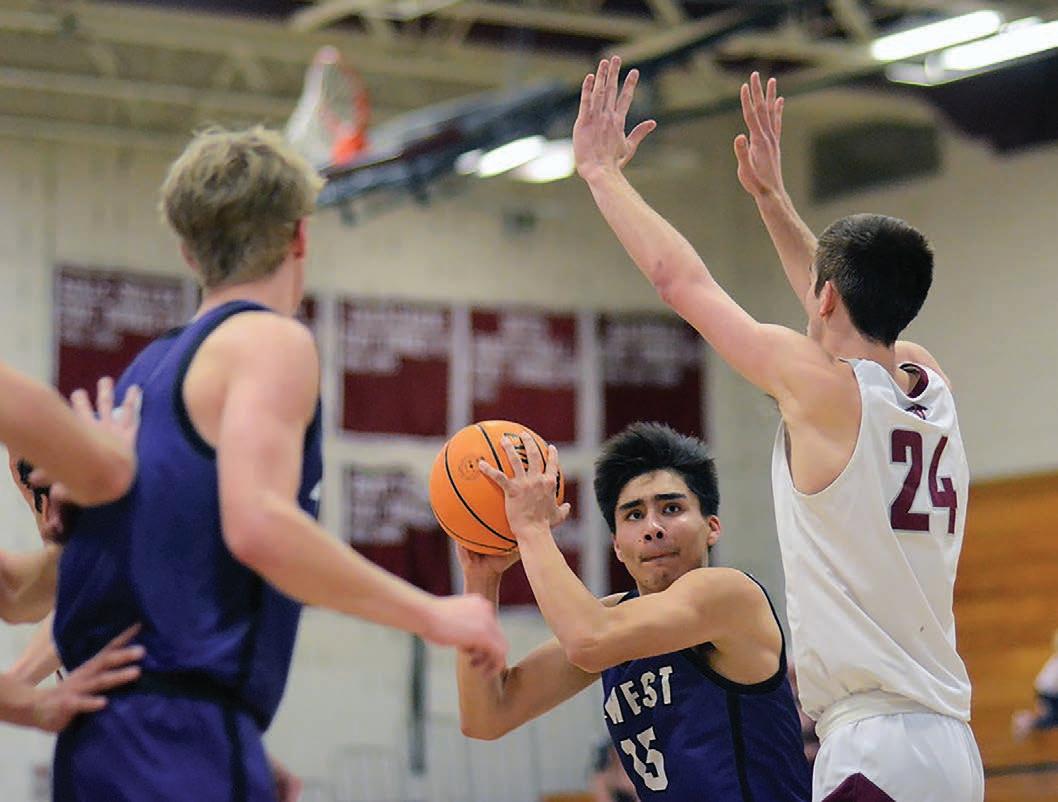
Sophomore Jordan Stremel had a big game o the bench with 13 points, including three 3-pointers for A-West.
“ ankfully Jordan gave us that boost o ensively,” Parriott said. “We really needed that after Jasper picked up his second foul and had to set a little bit in that rst half.”





Junior James Hadzic had 8 points, but his biggest contribution in the fourth quarter was taking two defensive charges.
“If those kind of small things don’t happen we don’t win the game,” Nichols said of Stremel’s pair of 3-pointers and Hadzic’s two defensive plays in fourth quarter. “ ose were big by those guys.”
Chat eld (5-15, 1-8) has lost 10-of-11 games, but de ntely had a strong showing against the lWildcats. Senior Shay Rumsey had 21 points for the Chargers. Senior Donovan Doyle came o the bench with 11 points, including two 3-pointers in the nal 22 seconds that cut the Wildcats’ lead to 1-point on both occasions.
“I thought Chat eld outplayed us. I thought they played harder and played smarter than we did,” Parriott said.
Chat eld has the chance to play spoiler in its nal two games. e Chargers are at Valor (Wednesday, Feb. 15) and home against Ralston Valley (Friday, Feb. 17). It isn’t likely that Chat eld will make the 32-team eld for the 6A state tournament. e Chargers were No. 44 in the RPI standings before Tuesday’s games.
A-West closes out the regular season at home versus Columbine (Friday, Feb. 17). e Wildcats were No. 17 in the RPI standings. e top-16 seeds get a home game for the rst round of the 32-team 6A state tournament that begins next week.
Class 5A Region 2 Wrestling Tournament






























































































Pomona freshman Zaidyn Quinonez, top, puts the finishing touches on a pin of Smoky Hill sophomore Dashawn Jenkins during the 106-pound semifinal match at the Class 5A Region 2 tournament. Quinonez won an individual regional title and the Panthers won the regional team title with 318 points.

Lakewood senior Isaiah Sisneros prepares for the semifinal round of the Class 5A Region 2 tournament hosted by Lakewood High School on Feb. 11. Sisneros captured the 113-pound regional title to qualify for the state tournament that begins Thursday, Feb. 16, at Ball Arena in Denver.

Help Wanted
USIC HIRING FULL- TIME UTILITY LOCATORS


100% Paid Training - Company vehicle & equipment providedMedical, Dental, Vision and Life Insurance Requirements: - Must be able to work outdoors - Ability to work OT & weekends - Must have valid driver’s license with safe driving records Text “USIC” to 90206 or visit: www.workatusic.com We are an Equal Opportunity Employer

Project Engineer



In Westminster, CO: Communicates & coordinates project design with Design Team members in completing design packages & changes arising during pre-construction. Requires: Master’s degree. Mail CV to: MBR Electric, Inc., 7135 Newton Street, Westminster, CO 80030. Attn: VP, Ref. job code HK.
Live In Caregiver/ Life Facilitator


Seeking an experienced caregiver to live in and care for a lady recovering from cancer in a beautiful home in Evergreen ,CO. A vehicle and valid driver license required. Duties; driving in snow,preparing meals,refilling prescriptions,grocery shopping,house cleaning,on call 5 days a week,managing calendar. Professional non-smoker wanted no pets. Vaccinations required. Looking for a long term Live in companion. Knowledge of diabetes is a bonus. On call 24/7 5 days a week with two days off. Send resume; aspenpark13@gmail.com
Help Wanted
DRIVER
Class B CDL propane delivery truck driver for Spring
SERVICE DIRECTORY ADS

Classifieds
Instruction
GUITAR LESSONS
Beginner – advanced acoustic and electric I can teach you what you want to learn!
Songs – music theory etc. Lessons are taught in my home. 30 years teaching experience. Any day, any time flexible scheduling. Call Leon 303-427-1953
Misc. Notices
WIDOWED MEN AND WOMEN OF AMERICA.
A social club offering many exciting activities and life long friendships. Social hours for all areas of Metro Denver. Visit Widowedamerica.org for details In your area!
2 bicycles, single bed complete never used, wheelchair, new poker table and shop vacuum. All for $500 or best offer. Will sell single items as well. Call 720-465-9022
Merchandise
Antiques & Collectibles
Medical
Attention oxygen therapy users! Inogen One G4 is capable of full 24/7 oxygen delivery. Only 2.8 pounds. Free info kit. Call 877-929-9587
Miscellaneous
Old Crows Antiques featuring The Root Beer Bar An Antique destination in Littleton Colorado Join us on Memory Lane. Something for everyone. Visit us for store info Instagram: @oldcrowsantiques www.facebook.com/ oldcrowsantiques www.oldcrows antiques.com

Firewood

Health & Beauty
VIAGRA and CIALIS USERS!
50 Generic Pills SPECIAL $99.00 100% guaranteed. 24/7 CALL NOW!
888-445-5928 Hablamos Espanol
DENTAL INSURANCEPhysicians Mutual Insurance Company. Covers 350 procedures. Real insurancenot a discount plan. Get your free dental info kit! 1-855-526-1060 www.dental50plus.com/58 #6258.
DISH TV $64.99 190 Channels + $14.95 High Speed Internet. Free Installation, Smart HD DVR included, Free Voice remote. Some Restrictions apply. Promo Expires 1/31/24. 1-866-479-1516. Switch and save up to $250/yr on talk, text & data. No contract or hidden fees. Unlimited talk & text with flexible data plans. Premium nationwide coverage. 100% U.S. based customer service. Limited time get $50 off any new account. Use code GIFT50. 1-855-903-3048
Free high speed internet if qualified. Govt. pgm for recipients of select pgms incl. Medicaid, SNAP, Housing Assistance, WIC, Veterans Pension, Survivor Benefits, Lifeline, Tribal. 15 GB internet. Android tablet free w/one-time $20 copay. Free shipping. Call Maxsip Telecom! 1-833-758-3892
Attention Homeowners! If you have water damage and need cleanup services, call us! We’ll get in & work with your insurance agency to get your home repaired and your life back to normal ASAP! 855-7677031
MobileHelp, America’s premier mobile medical alert system. Whether you’re home or away. For safety & peace of mind. No long term contracts! Free brochure! 1-888489-3936
BATH & SHOWER UPDATES in as little as ONE DAY! Affordable prices - No payments for 18 months! Lifetime warranty & professional installs. Senior & Military Discounts available. Call: 855-761-1725
Donate Your Car to Veterans Today! Help and Support our Veterans. Fast - FREE pick up. 100% tax deductible. Call 1-800245-0398
DEADLINES
CLASSIFIED LINE ADS: MONDAY, 11 A.M.

SERVICE DIRECTORY:
THURSDAY, 5 P.M.
LEGALS: THURSDAY, 3 P.M.
Colorado Statewide Network




To place a 25-wordCOSCAN Network adin 91 Colorado newspapers for only $300, contact your local newspaper or email Colorado Press Association Network at rtoledo@colopress.net





PORTABLE OXYGEN DIRECTV
Get DIRECTV for $84.99/mo for 24 months with CHOICE Package. NEW 2 YEAR PRICE
GUARANTEE. First 3 months of HBO Max, Cinemax, Showtime, Starz and Epix included! Directv is #1 in Customer Satisfaction (JD Power & Assoc.) Some restrictions apply! Call 1-888-725-0897
AMERIGLIDE



Don't let the stairs limit your mobility!
Discover theideal solution for anyone who struggles on the stairs, is concerned about a fallor wants to regainaccess to their entire home. Call AmeriGlide today! 1-877-418-1883
Miscellaneous
Scrap Metal, Batteries, Appliances, Wiring, Scrap Plumbing/Heating, Cars/Parts, Clean out Garages/Yards, Rake, Yard work done w/chainsaw, Certified Auto Mechanical / Body Work & paint available Also can do inside or outside cleaning 303-647-2475 / 720-323-2173
HughesNet– Finally, super-fast internet no matter where you live. 25 Mbps just $59.99/mo! Unlimited Data is Here. Stream Video. Bundle TV & Internet. Free Installation. Call 866-499-0141
!!OLD GUITARS WANTED!! GIBSON, FENDER, MARTIN, etc. 1930’s to 1980’s. TOP DOLLAR PAID.
CALL TOLL FREE 1-866-433-8277
The Generac PWRcell solar plus battery storage system. Save money, reduce reliance on grid, prepare for outages & power your home. Full installation services. $0 down financing option. Request free no obligation quote. 1-877-539-0299
Portable Oxygen Concentrator. May be Covered by Medicare!
Reclaim independece
HAPPY
Miscellaneous
Safe Step. North America’s #1 Walk-in tub. Comprehensive lifetime warranty. Top-of-the-line installation and service. Now featuring our free shower package & $1600 off - limited time! Financing available. 1-855-4171306
Caring for an aging loved one? Wondering about options like seniorliving communities and in-home care? Caring.com’s Family Advisors help take the guesswork out of senior care for your family. Free, noobligation consult: 1-855-759-1407
Prepare for power outages today with a GENERAC home standby generator $0 Down + Low Monthly Pmt Request a free Quote. Call before the next power outage: 1-855-948-6176
Wesley Financial Group, LLC Timeshare Cancellation Experts Over $50,000,000 in timeshare debt & fees cancelled in 2019. Get free info package & learn how to get rid of your timeshare! Free consultations. Over 450 positive reviews. Call 833-308-1971
DANIEL’S PAINTING










































































































FOR THE RECORD
damaging racial inequalities are in the United States, according to city consultants. However, the REDI Action Plan is overall intersectional, examining how to make Golden a better place for people of all ages, abilities, gender identities, sexual orientations, socioeconomic backgrounds, religions and other demographics.

O cials said the next step is to assemble an implementation team of community members and city staers to make recommendations to City Council on how to achieve goals. Golden expects to assemble the team this spring.
In a Feb. 10 email, Mayor Laura Weinberg highlighted city o cials and community members’ ongoing work to “live up to our value as a welcoming and inclusive city.”
“I applaud the Golden Transcript’s work to identify its role in racial inequities in the past and its role in systemic racism,” she stated. “ e City of Golden has undertaken similar work … (and) I look forward to this year’s actions to take the information from our new REDI plan and put community-driven solutions into practice.”
For the Golden Transcript
While the Transcript’s ownership and newsroom has changed greatly since the late 1960s and early ’70s, it’s not immune from the biases and attitudes that riddled its past coverage and contributed to systemic racism in and around Golden.
Scrable said reading the Transcript’s past coverage of the Black community can be “demoralizing,” but even recent stories have failed to represent Black voices.
TO BE YOU.
He pointed to an Aug. 31, 2020 Transcript story about City Council’s decision to display a “Golden Stands With Black Lives” banner over Washington Avenue. e story said the banner would be displayed for 60 days, “an amount of time intended to symbolize how long it took for slave ships to cross the Atlantic.”

Scrable and his GAC co-chairs did advocate for 60 days, but they never assigned any symbolism or signicance to the number.
“It might’ve been said (in the meeting), but it wasn’t us,” Scrable said of GAC. “It was a misquote.”
After the Aug. 31, 2020 story, Scrable received about 20 phone calls from people upset about the supposed symbolism. He felt the Transcript hadn’t done enough research and ultimately misrepresented the facts, and that insensitivity created a very frustrating
experience.
He wanted the Transcript to ensure there are positive stories about people from historically marginalized groups, and do better educating Goldenites about their neighbors’ achievements and experiences.
Scrable added: “I’m looking to the Transcript to paint a positive picture for all people of color … and representing ‘all’ versus ‘a few.’” e Colorado Community Media newsroom acknowledges it has work to do, and this February 2023 report is only the rst step in what the team hopes will open a wider conversation about systemic racism and media coverage for years to come. Working on this report brought CCM sta members face-to-face with outdated practices and implicit biases.
Going forward, CCM’s goal is to include more voices of color in the


newsroom and on the pages of its two dozen publications, Publisher Linda Shapley said. CCM wants to ensure all local voices are heard and included, while also re ecting on racial equity, diversity and inclusion. CCM will strive to consider the lenses through which the sta decides to cover stories in the rst place. Appreciating di erences in CCM’s coverage areas, like history and culture, will guide the newsroom in its e orts.
Other newspapers such as e New York Times, the Washington Post, e Kansas City Star, Philadelphia Inquirer and more have done similar analyses of their past coverage, and the Transcript encourages other newspapers in the region and across the country to do so as well, Shapley said, adding that it wouldn’t have been possible without a Colorado Media Project grant.

For all journalists, Porter stressed the importance of continuing to diversify newsrooms and ensuring fair, balanced and objective coverage and “stop convicting people without evidence.”
He called on more publications to review their past coverage and acknowledge its harmful impacts, saying it’s important to shine a light on the truth, to be honest and to be transparent.
“If we’re ever going to get past this, it’s going to take some truth-telling,” he said. “It will be hard. It will be di cult. But it really is one of the last vestiges to make this country what it said it was in the beginning — freedom and liberty for all. Which has not been the case for us.”
Jameka Lewis, Allan Tellis, Kristen Fiore, Rylee Dunn, Christy Steadman, Steve Smith and Deborah Grigsby contributed to this report. Greg Moore contributed as an editor.




















































































